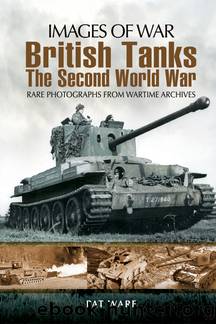British Tanks by Pat Ware

Author:Pat Ware
Language: eng
Format: epub
Tags: Bisac Code 1: HIS027100: HISTORY / Military / World War II
ISBN: eBook ISBN: 9781783038374
Publisher: Pen & Sword Books
Published: 2011-12-13T00:00:00+00:00
Infantry Tank Mk IV (A22)âChurchill
With a total of 5,640 unitsâsome sources suggest even moreâconstructed over a five-year period, the Churchill was the second most numerous British tank of the Second World War. Once the initial teething problems had been solved it also became one of the most reliable. Unfortunately, although it was well armoured, as with most Allied tanks its firepower was sadly inadequate when confronted with the German 75mm and 88mm guns.
The work that eventually led to the development of the A22 Churchill started in September 1939 when the Belfast shipyard of Harland and Wolff was commissioned to construct four prototypes for a new infantry tank designated A20. The prototypes were completed by June 1940 and were powered by a twelve-cylinder Meadows engine, which quickly proved itself to be insufficiently powerful. The vehicle was also plagued by transmission troubles.
By this time, events in France had shown that this would be a war of movement and that notions of trench warfare should be forgotten. Clearly, the A20 was obsolete but, using the best features of the design as a starting point, H. E. Merritt, the Director of Tank Design, drew up a specification for yet another infantry tank, this time designated A22. Now there was a new twist to the equationâthe shortages of equipment resulting from the abandonment of so much materiel on the beaches of northern France and Belgium dictated a tight timescale and the War Office insisted that the A22 be ready for production within twelve months. Vauxhall Motors had been working on a horizontally opposed twelve-cylinder engine to replace the Meadows unit of the A20, and it was decided to move the A22 development work from Harland and Wolff to Vauxhall. To save time, Vauxhall retained the basic Harland and Wolff hull and the sprung-bogie suspension. The Bedford flat-twelve engine was also retained, producing 325â350bhp from a capacity of 21,240cc and driving the rear sprockets via a Merritt-Brown five-speed gearbox and epicyclic steering unitâalthough after just 100 vehicles had been constructed, the five-speed transmission was replaced by a four-speed unit. The first pilot model was ready by November 1940.
The hull was of composite construction, consisting of an outer covering of armour plate bolted to a mild-steel inner skin, giving a maximum thickness of armour of 102mm; on the later Mks VII and VIII versions, the thickness of armour was increased to 152mm. The first version was fitted with a cast turret, but this was later superseded by a larger turret of either cast, welded or composite construction.
It was a large and relatively heavy machineâthe hull measured 293in in length and was 100in wide, with the width increased to 108in from the Mk III onwards, but at least there was plenty of room for the five-man crew. The combat weight was 39 tons, rising to 40 tons for the Mks VII and VIII and this held the top speed down to around 17mph, reducing to 12.5mph for the heavier Mks VII and VIII.
The first two variants were armed with the 2-pounder (40mm) gun in a cast turret, with a coaxial 7.
Download
This site does not store any files on its server. We only index and link to content provided by other sites. Please contact the content providers to delete copyright contents if any and email us, we'll remove relevant links or contents immediately.
| Biological & Chemical | Conventional |
| Nuclear |
The Radium Girls by Kate Moore(11964)
100 Deadly Skills by Clint Emerson(4875)
Rise and Kill First by Ronen Bergman(4736)
The Templars by Dan Jones(4653)
The Doomsday Machine by Daniel Ellsberg(4446)
The Rape of Nanking by Iris Chang(4165)
Killing England by Bill O'Reilly(3968)
Hitler in Los Angeles by Steven J. Ross(3922)
Stalin by Stephen Kotkin(3916)
12 Strong by Doug Stanton(3525)
Hitler's Monsters by Eric Kurlander(3287)
Blood and Sand by Alex Von Tunzelmann(3164)
The Code Book by Simon Singh(3122)
Darkest Hour by Anthony McCarten(3095)
The Art of War Visualized by Jessica Hagy(2971)
Hitler's Flying Saucers: A Guide to German Flying Discs of the Second World War by Stevens Henry(2729)
Babylon's Ark by Lawrence Anthony(2643)
The Second World Wars by Victor Davis Hanson(2501)
Tobruk by Peter Fitzsimons(2475)
